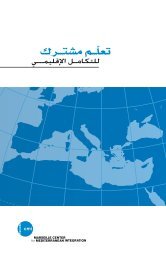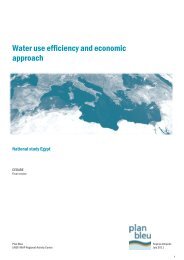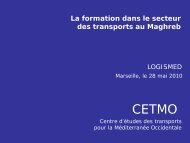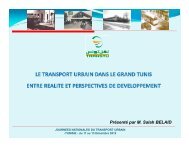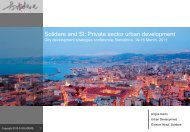Why is it important and how to participate? Mark Keese, OECD - CMI
Why is it important and how to participate? Mark Keese, OECD - CMI
Why is it important and how to participate? Mark Keese, OECD - CMI
Create successful ePaper yourself
Turn your PDF publications into a flip-book with our unique Google optimized e-Paper software.
PIAAC<br />
Programme for the International Assessment of Adult Competencies<br />
PIAAC: a new window on adult skills<br />
<strong>Mark</strong> <strong>Keese</strong><br />
(mark.keese@oecd.org)<br />
World Bank Seminar on “Enhancing Qualifications Frameworks <strong>and</strong> Qual<strong>it</strong>y Assurance in MENA”,<br />
Marseille, 14-15 June 2010
Outline<br />
What <strong>is</strong> PIAAC <strong>and</strong> what progress has<br />
been made?<br />
<strong>Why</strong> do we need PIAAC?<br />
How can MENA be involved?
What <strong>is</strong> PIAAC <strong>and</strong> what progress has been made?
PIAAC’s scope:<br />
What <strong>is</strong> PIAAC?<br />
The most comprehensive international survey of adult skills ever<br />
undertaken<br />
Measures the skills <strong>and</strong> competencies needed for individuals <strong>to</strong><br />
<strong>participate</strong> in society <strong>and</strong> for economies <strong>to</strong> prosper<br />
Will help governments better underst<strong>and</strong> <strong>how</strong> education <strong>and</strong> training<br />
systems <strong>and</strong> other labour market policies can nurture these skills<br />
How will <strong>it</strong> be carried out?<br />
A collaboration between governments, an international consortium of<br />
organ<strong>is</strong>ations <strong>and</strong> the <strong>OECD</strong><br />
It will take place in 28 <strong>OECD</strong> <strong>and</strong> partner countries in 2011-2012 w<strong>it</strong>h<br />
results publ<strong>is</strong>hed in 2013<br />
Based on a household-based survey of adults (minimum of 5000<br />
respondents per country)
Measures of l<strong>it</strong>eracy,<br />
numeracy & problemsolving<br />
skills<br />
o Direct assessment<br />
What does PIAAC measure?<br />
Measures of generic<br />
skills used at work<br />
o Job Requirements<br />
Approach (JRA)<br />
Measures of skill<br />
formation & outcomes<br />
o Background questions<br />
on adult learning, labourmarket<br />
status, earnings,<br />
health …
Direct assessment module<br />
Objective: To provide assessment of adult l<strong>it</strong>eracy in the<br />
information age, covering 4 broad domains of competency<br />
L<strong>it</strong>eracy Numeracy L<strong>it</strong>eracy<br />
component skills<br />
Problem solving in<br />
an IT context<br />
L<strong>it</strong>eracy defined as “interest, att<strong>it</strong>ude <strong>and</strong> abil<strong>it</strong>y of individuals <strong>to</strong><br />
appropriately use socio-cultural <strong>to</strong>ols, including dig<strong>it</strong>al technology <strong>and</strong><br />
communication <strong>to</strong>ols, <strong>to</strong> access, manage, integrate <strong>and</strong> evaluate<br />
information, construct new knowledge, <strong>and</strong> communicate w<strong>it</strong>h others in<br />
order <strong>to</strong> <strong>participate</strong> effectively in society”<br />
Involves a 60-minute test
Generic workplace skills covered by PIAAC<br />
Cogn<strong>it</strong>ive skills<br />
Reading, Wr<strong>it</strong>ing,<br />
Maths, IT,<br />
Problem Solving<br />
Key<br />
workplace<br />
skills<br />
Interaction/social skills<br />
Physical skills Learning skills<br />
Stamina, Strength,<br />
Dexter<strong>it</strong>y<br />
Influence, Selfdirection,<br />
Horizontal<br />
interaction, Client<br />
interaction<br />
Required <strong>to</strong> learn<br />
things, Keep up <strong>to</strong><br />
date, Help others<br />
learn
Progress w<strong>it</strong>h PIAAC<br />
Survey instruments have been developed<br />
Field trial now underway in most participating countries<br />
A large scale exerc<strong>is</strong>e involving 1500 respondents in each country<br />
Will be used <strong>to</strong> validate instruments <strong>and</strong> test survey procedures<br />
May-July<br />
2010<br />
July 2011-<br />
Feb 2012<br />
Sep 2013<br />
PIAAC Timeline<br />
• Field trial<br />
• Full survey <strong>to</strong> take place<br />
• First PIAAC international<br />
report <strong>to</strong> be released
<strong>Why</strong> do we need PIAAC?
10<br />
Key areas where PIAAC will tell us more<br />
Outcomes<br />
of skills<br />
International<br />
benchmarking<br />
PIAAC<br />
results<br />
Skill<br />
acqu<strong>is</strong><strong>it</strong>ion<br />
D<strong>is</strong>tribution<br />
of skills
International benchmarking<br />
Key policy <strong>is</strong>sues:<br />
Are there clear differences in country performance in the cogn<strong>it</strong>ive<br />
assessment (even allowing for differences in GDP per cap<strong>it</strong>a, etc.)<br />
which point <strong>to</strong> better performing education <strong>and</strong> training systems?<br />
How well <strong>is</strong> each country doing in adapting <strong>it</strong>s skill development policies<br />
<strong>to</strong> a technology-rich environment <strong>and</strong> increasing international trade?<br />
Have l<strong>it</strong>eracy <strong>and</strong> numeracy skills improved over time in line w<strong>it</strong>h<br />
changes in education <strong>and</strong> training systems?
PISA reading score (mean)<br />
600<br />
550<br />
500<br />
450<br />
400<br />
350<br />
300<br />
250<br />
Benchmarking<br />
KOR<br />
FIN<br />
CAN HKG<br />
NZL AUS<br />
POL<br />
SWE IRL<br />
EST<br />
JPN BEL<br />
NLD CHE<br />
SVN DEU DNK<br />
HRV HUN CZE<br />
GBR USA*<br />
FRA<br />
LVA AUT<br />
GRC<br />
ISL<br />
LTU<br />
SVK<br />
PRT ITA<br />
TUR<br />
ESP<br />
CHL RUS<br />
ISR<br />
THA<br />
URY<br />
JOR<br />
SRB BGR MEX<br />
BRA MNE<br />
IDN COL ROM<br />
TUN ARG<br />
KGZ<br />
PISA mean reading scores <strong>and</strong> GDP per cap<strong>it</strong>a, 2006*<br />
AZE<br />
ISL<br />
LUX<br />
y = 63.015ln(x) - 157.58<br />
R² = 0.7178<br />
0 10000 20000 30000 40000 50000 60000 70000<br />
GDP per cap<strong>it</strong>a ($US in PPPs)<br />
* 2003 score for the Un<strong>it</strong>ed States.<br />
Source: <strong>OECD</strong> for PISA scores <strong>and</strong> World Bank for GDP per cap<strong>it</strong>a.
Key policy <strong>is</strong>sues:<br />
D<strong>is</strong>tribution of skills<br />
Are education <strong>and</strong> training inst<strong>it</strong>utions failing <strong>to</strong> give some groups<br />
adequate skills for economic <strong>and</strong> social success?<br />
What <strong>is</strong> the relative importance of education versus socioeconomic<br />
background in determining skills that adults have <strong>and</strong> use? Do some<br />
countries do better than others in terms of leveling the playing field?
Skill acqu<strong>is</strong><strong>it</strong>ion (<strong>and</strong> loss)<br />
Key policy <strong>is</strong>sues:<br />
How well are countries performing in imparting youths w<strong>it</strong>h essential<br />
cogn<strong>it</strong>ive skills <strong>and</strong> ensuring smooth labour-market entry?<br />
What <strong>is</strong> the role of education/training, work experience <strong>and</strong> work<br />
organ<strong>is</strong>ation?
Skill acqu<strong>is</strong><strong>it</strong>ion (<strong>and</strong> loss)<br />
What <strong>is</strong> the contribution of further education <strong>and</strong> work experience <strong>to</strong><br />
skill acqu<strong>is</strong><strong>it</strong>ion?<br />
Share of adults w<strong>it</strong>h high l<strong>it</strong>eracy levels by age<br />
Source: Cascio, Clark <strong>and</strong> Gordon (2008) based on IALS data.
Key policy <strong>is</strong>sues:<br />
Outcomes of skills<br />
Is there a pay-off <strong>to</strong> investments in education <strong>and</strong> training, <strong>and</strong> in which<br />
skills <strong>and</strong> for whom? What <strong>is</strong> the role of broader inst<strong>it</strong>utional settings?<br />
PIAAC will be able <strong>to</strong> go much further at looking at returns <strong>to</strong> education <strong>and</strong><br />
skills by including analys<strong>is</strong> of filed of education, assessed skills <strong>and</strong> a broad<br />
range of skills used at work<br />
In our modern IT world, <strong>how</strong> <strong>important</strong> are computer <strong>and</strong> problemsolving<br />
skills? What other skills matter <strong>and</strong> why?<br />
Is over-education <strong>important</strong> <strong>and</strong> why do countries differ? Does<br />
education m<strong>is</strong>match mean a skills m<strong>is</strong>match?
100%<br />
Skills m<strong>is</strong>match<br />
Provides measures of both education <strong>and</strong> skills m<strong>is</strong>match<br />
90%<br />
80%<br />
70%<br />
60%<br />
50%<br />
40%<br />
30%<br />
20%<br />
10%<br />
0%<br />
Proportion of workers over-qualified highest in Korea but relatively fewer<br />
over-skilled workers<br />
In Australia <strong>and</strong> Korea, over-qualifications (under-qualifications) are<br />
associated w<strong>it</strong>h a large earnings penalty (premium)<br />
Source: <strong>OECD</strong> JRA Pilot Study (general sample).<br />
Education <strong>and</strong> skill match<br />
A. Education match B. Skill match<br />
% of workers by match category % of workers by match category<br />
Over-qualified Matched Under-qualified<br />
Australia France Greece Korea<br />
100%<br />
90%<br />
80%<br />
70%<br />
60%<br />
50%<br />
40%<br />
30%<br />
20%<br />
10%<br />
0%<br />
Over-skilled Matched Under-skilled<br />
Australia France Greece Korea
How can MENA be involved?
A special assessment round<br />
A special assessment round could be carried out for MENA <strong>and</strong><br />
other add<strong>it</strong>ional countries:<br />
Based on the PIAAC methodology <strong>and</strong> giving comparable results w<strong>it</strong>h those from<br />
the first round<br />
The cogn<strong>it</strong>ive assessment (of l<strong>it</strong>eracy, numeracy, etc.) would be carried out by<br />
“pencil <strong>and</strong> paper” <strong>and</strong> include add<strong>it</strong>ional <strong>it</strong>ems as necessary<br />
Some adaptation of the background questionnaire <strong>to</strong> individual country<br />
circumstances would be possible<br />
Infrastructure <strong>to</strong> support implementation of the survey (e.g. engage international<br />
contrac<strong>to</strong>r <strong>to</strong> develop survey <strong>and</strong> oversee <strong>it</strong>s implementation) would be<br />
establ<strong>is</strong>hed in partnership w<strong>it</strong>h the <strong>OECD</strong> <strong>and</strong> World Bank
Roles <strong>and</strong> responsibil<strong>it</strong>ies<br />
International level by project contrac<strong>to</strong>r:<br />
Prepare survey instruments <strong>and</strong> survey design<br />
Carry out central<strong>is</strong>ed translation of survey instruments <strong>and</strong> training manuals<br />
Prepare <strong>and</strong> provide training<br />
Survey support <strong>and</strong> qual<strong>it</strong>y control<br />
Analys<strong>is</strong>, cleaning <strong>and</strong> scaling of survey results<br />
Provide data products for analys<strong>is</strong> <strong>and</strong> d<strong>is</strong>semination of results<br />
National level by participating countries:<br />
Adapting survey instruments <strong>to</strong> national context <strong>and</strong> verifying translation<br />
Appointment of National Project Manager (NPM) <strong>and</strong> project team<br />
Attending NPM meetings<br />
Admin<strong>is</strong>tration of field trial <strong>and</strong> main survey<br />
Preparation <strong>and</strong> cleaning of national data files
Possible timeline for MENA participation in PIAAC<br />
End of 2010<br />
2011<br />
2012<br />
2013<br />
2014<br />
End 2015<br />
• Final<strong>is</strong>e country participation <strong>and</strong> funding<br />
arrangements<br />
• Adaptation <strong>and</strong> final<strong>is</strong>ation of instruments<br />
• Preparation for field trial<br />
• Undertake field trial<br />
• Analys<strong>is</strong> of field trial results<br />
• Rev<strong>is</strong>ion of instruments <strong>and</strong> procedures<br />
• Preparation for main data collection<br />
• Main data collection<br />
• Data preparation <strong>and</strong> analys<strong>is</strong><br />
• Release of report on results
How much will <strong>it</strong> cost?<br />
For international costs, in<strong>it</strong>ial estimate of 6 million euros for 6<br />
countries plus 390K euros for add<strong>it</strong>ional countries, spread over 5<br />
years<br />
For national costs, the main element would be the cost of<br />
carrying out a household survey of around 3500-4000 individuals
Conclusions<br />
PIAAC will open a new window on adult skills<br />
Participation in PIAAC would give each MENA country valuable<br />
insights in<strong>to</strong> where more can be done <strong>to</strong> improve skills based on<br />
internationally comparable data<br />
It will help identify which skills are essential, who has them <strong>and</strong><br />
where there are skill gaps<br />
Investing in training <strong>and</strong> skills <strong>is</strong> costly <strong>and</strong> PIAAC can help<br />
ensure that th<strong>is</strong> money <strong>is</strong> well spent<br />
For further details on PIAAC, see:<br />
www.oecd.org/piaac


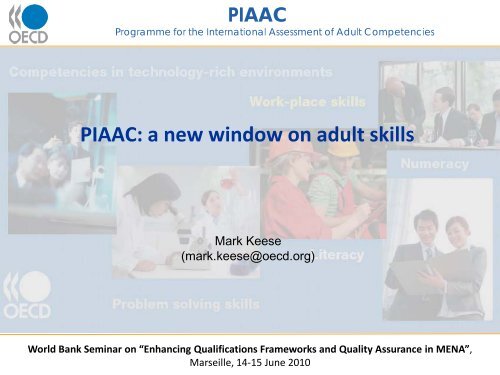


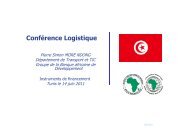
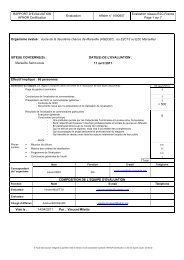
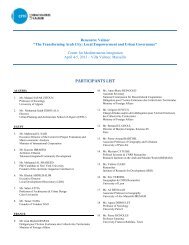

![5-Afif Mehri-SDU [Compatibility Mode] - CMI](https://img.yumpu.com/18242985/1/190x146/5-afif-mehri-sdu-compatibility-mode-cmi.jpg?quality=85)
